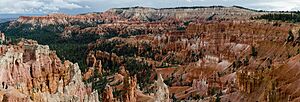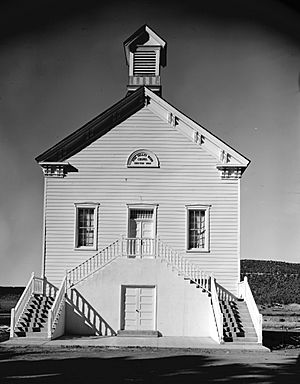Ebenezer Bryce facts for kids
Ebenezer Bryce (born November 17, 1830 – died September 26, 1913) was an important early settler in Utah. He is most famous because Bryce Canyon National Park was named after him. He was a Mormon pioneer, meaning he was one of the first members of The Church of Jesus Christ of Latter-day Saints to settle in the western United States.
Contents
Ebenezer Bryce's Early Life
Ebenezer Bryce was born in a town called Dunblane in Scotland on November 17, 1830. When he was young, he learned how to build ships. At age seventeen, he joined The Church of Jesus Christ of Latter-day Saints. He then left Scotland to move to Utah in the United States. He was the only one in his family to join the church.
Building in Pine Valley
In 1854, Ebenezer Bryce married Mary Park in Salt Lake City. By 1862, they had moved to southern Utah. They settled in a place called Pine Valley.
Ebenezer Bryce was a skilled builder. In 1868, he designed and helped build the Pine Valley Chapel. This chapel is special because its roof was built like an upside-down ship! Ebenezer used his shipbuilding skills from Scotland to create this unique design. The chapel is still used today, making it the oldest chapel of its kind in continuous use. It is also listed on the U.S. National Register of Historic Places. While in Pine Valley, Ebenezer also ran a sawmill. This sawmill provided wood for building the St. George Temple.
Connection to Bryce Canyon
After living in Pine Valley, Ebenezer and his family moved a short distance away. They settled near the Paria Valley, which is south of what we now call Bryce Canyon. This beautiful area became a National Monument in 1923. Later, in 1928, it became a full National Park. The park was named after Ebenezer Bryce because he was one of the first settlers in the area.
Later Life in Arizona
In 1880, Ebenezer Bryce moved his large family to Arizona. They settled about two miles north of Pima. A settlement there was named Bryce, Arizona in his honor. Ebenezer Bryce passed away in Arizona on September 26, 1913. He was buried in a local cemetery there.



